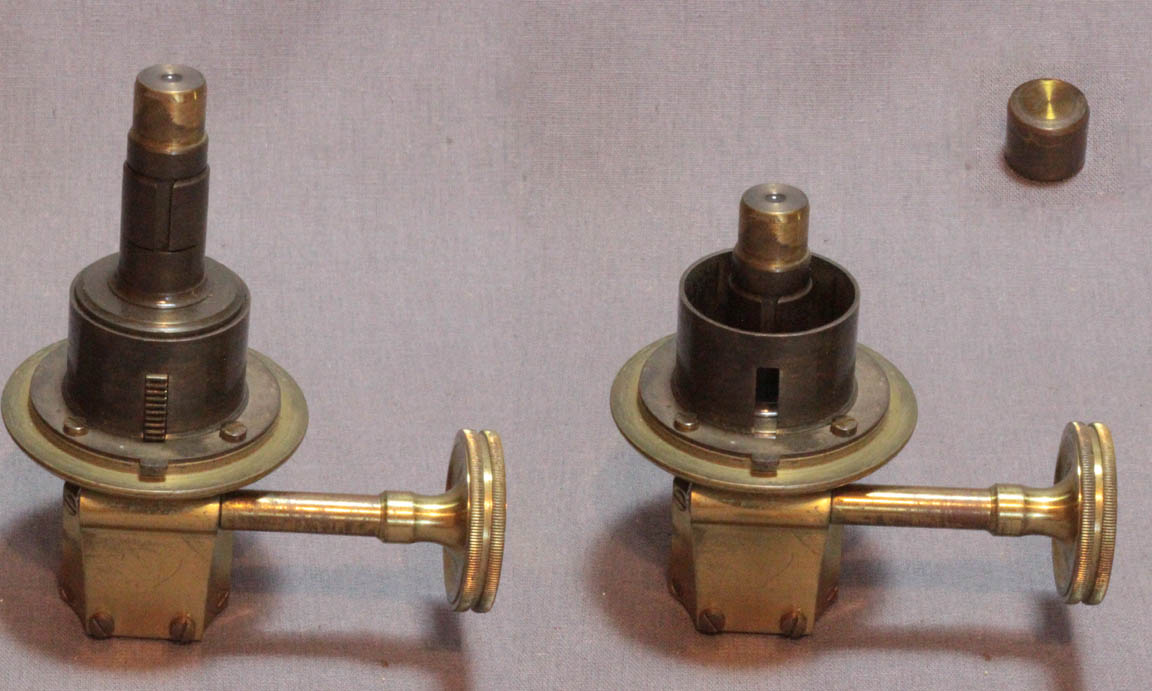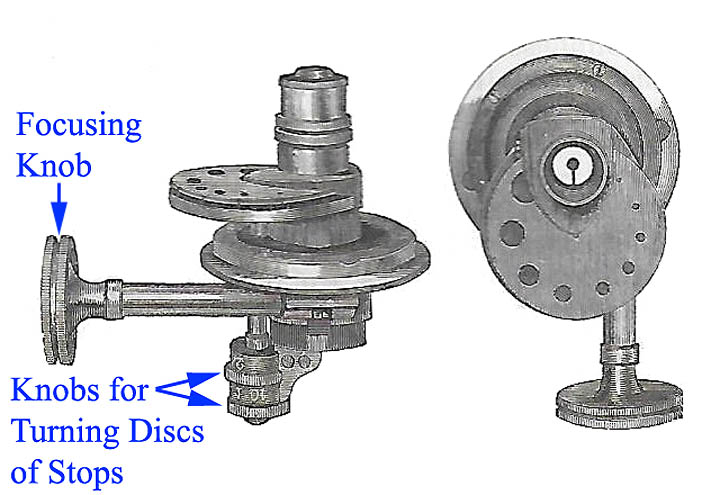THE ORIGINAL FORM OF 'NEW MICROSCOPE' OF POWELL & LEALAND
MAKER: POWELL & LEALAND
MODEL: 'NEW MICROSCOPE'
DATED: 1843
SIGNED ON THE ARM: 'Powell & Lealand, Makers, London' and also dated '1843'
THIS PAGE: Powell and Lealand's Achromatic substage Condenser

When these microscopes were first made, the condenser for use with high power objectives, shown above, was provided with the instrument. Because the stage is quite thick, the tube of this condenser has to be relatively long. To be able to focus it, the rack and pinion apparatus had to control it from below the underside of the stage. No control of aperture of this condenser, which was intended mainly for high power work, was provided. This condenser is used with the half inch and shorter focal length(higher power) objectives.
For lower powers, in this case the one inch and two inch objectives, a separate wheel or disk of different diameter apertures was also provided. Both of these pieces of apparatus have lugs to allow installation via the bayonet fitting under the stage, but only one or the other can be used at any one time. The substage condenser is supplied with a dust cap for its top. With the substage condenser the flat side of the mirror is used. When using the microscope without the substage condenser, i.e. with the wheel of apertures, the curved side of the mirror is used.
 By the 1850's, as shown in the illustration to the left from the 1856 volume of Carpenter's The Microscope and Its Revelations, a more complicated condenser could be supplied. It provided built in stops. To achieve this, it not only had to attach to the underside of the stage by a bayonet fitting, it had to be able to fit inside the deep stage so its top lens could approach the bottom of a slide. To do this, its stops were in two disks(or wheels), thereby reducing the size of the disks so they could fit into the relatively small opening in the bottom of the stage. Furthermore, the entire apparatus had to be adjusted from below, by controls projecting below the bottom of the stage. The two controls for the wheels of stops were concentric and there were markings to indicate which stops were in the optical path. This anticipates, to great extent, and was undoubtedly the inspiration for, the later substage-mounted Ross Improved Gillette Condenser. The rack and pinion focusing of this P & L condenser was also controlled by a knob on a fitting protruding below the understage mounting. Although rack and pinion substages, which would accept multiple pieces of apparatus, were being added to the larger transitional P & L models no later than 1856, the integrated rack and pinion substage was not used on this smaller size of microscope until the No 3 model came into existance in the 1860's. Until that time, this type of understage condenser with bayonet fitting was still being used.
By the 1850's, as shown in the illustration to the left from the 1856 volume of Carpenter's The Microscope and Its Revelations, a more complicated condenser could be supplied. It provided built in stops. To achieve this, it not only had to attach to the underside of the stage by a bayonet fitting, it had to be able to fit inside the deep stage so its top lens could approach the bottom of a slide. To do this, its stops were in two disks(or wheels), thereby reducing the size of the disks so they could fit into the relatively small opening in the bottom of the stage. Furthermore, the entire apparatus had to be adjusted from below, by controls projecting below the bottom of the stage. The two controls for the wheels of stops were concentric and there were markings to indicate which stops were in the optical path. This anticipates, to great extent, and was undoubtedly the inspiration for, the later substage-mounted Ross Improved Gillette Condenser. The rack and pinion focusing of this P & L condenser was also controlled by a knob on a fitting protruding below the understage mounting. Although rack and pinion substages, which would accept multiple pieces of apparatus, were being added to the larger transitional P & L models no later than 1856, the integrated rack and pinion substage was not used on this smaller size of microscope until the No 3 model came into existance in the 1860's. Until that time, this type of understage condenser with bayonet fitting was still being used.

 By the 1850's, as shown in the illustration to the left from the 1856 volume of Carpenter's The Microscope and Its Revelations, a more complicated condenser could be supplied. It provided built in stops. To achieve this, it not only had to attach to the underside of the stage by a bayonet fitting, it had to be able to fit inside the deep stage so its top lens could approach the bottom of a slide. To do this, its stops were in two disks(or wheels), thereby reducing the size of the disks so they could fit into the relatively small opening in the bottom of the stage. Furthermore, the entire apparatus had to be adjusted from below, by controls projecting below the bottom of the stage. The two controls for the wheels of stops were concentric and there were markings to indicate which stops were in the optical path. This anticipates, to great extent, and was undoubtedly the inspiration for, the later substage-mounted Ross Improved Gillette Condenser. The rack and pinion focusing of this P & L condenser was also controlled by a knob on a fitting protruding below the understage mounting. Although rack and pinion substages, which would accept multiple pieces of apparatus, were being added to the larger transitional P & L models no later than 1856, the integrated rack and pinion substage was not used on this smaller size of microscope until the No 3 model came into existance in the 1860's. Until that time, this type of understage condenser with bayonet fitting was still being used.
By the 1850's, as shown in the illustration to the left from the 1856 volume of Carpenter's The Microscope and Its Revelations, a more complicated condenser could be supplied. It provided built in stops. To achieve this, it not only had to attach to the underside of the stage by a bayonet fitting, it had to be able to fit inside the deep stage so its top lens could approach the bottom of a slide. To do this, its stops were in two disks(or wheels), thereby reducing the size of the disks so they could fit into the relatively small opening in the bottom of the stage. Furthermore, the entire apparatus had to be adjusted from below, by controls projecting below the bottom of the stage. The two controls for the wheels of stops were concentric and there were markings to indicate which stops were in the optical path. This anticipates, to great extent, and was undoubtedly the inspiration for, the later substage-mounted Ross Improved Gillette Condenser. The rack and pinion focusing of this P & L condenser was also controlled by a knob on a fitting protruding below the understage mounting. Although rack and pinion substages, which would accept multiple pieces of apparatus, were being added to the larger transitional P & L models no later than 1856, the integrated rack and pinion substage was not used on this smaller size of microscope until the No 3 model came into existance in the 1860's. Until that time, this type of understage condenser with bayonet fitting was still being used.